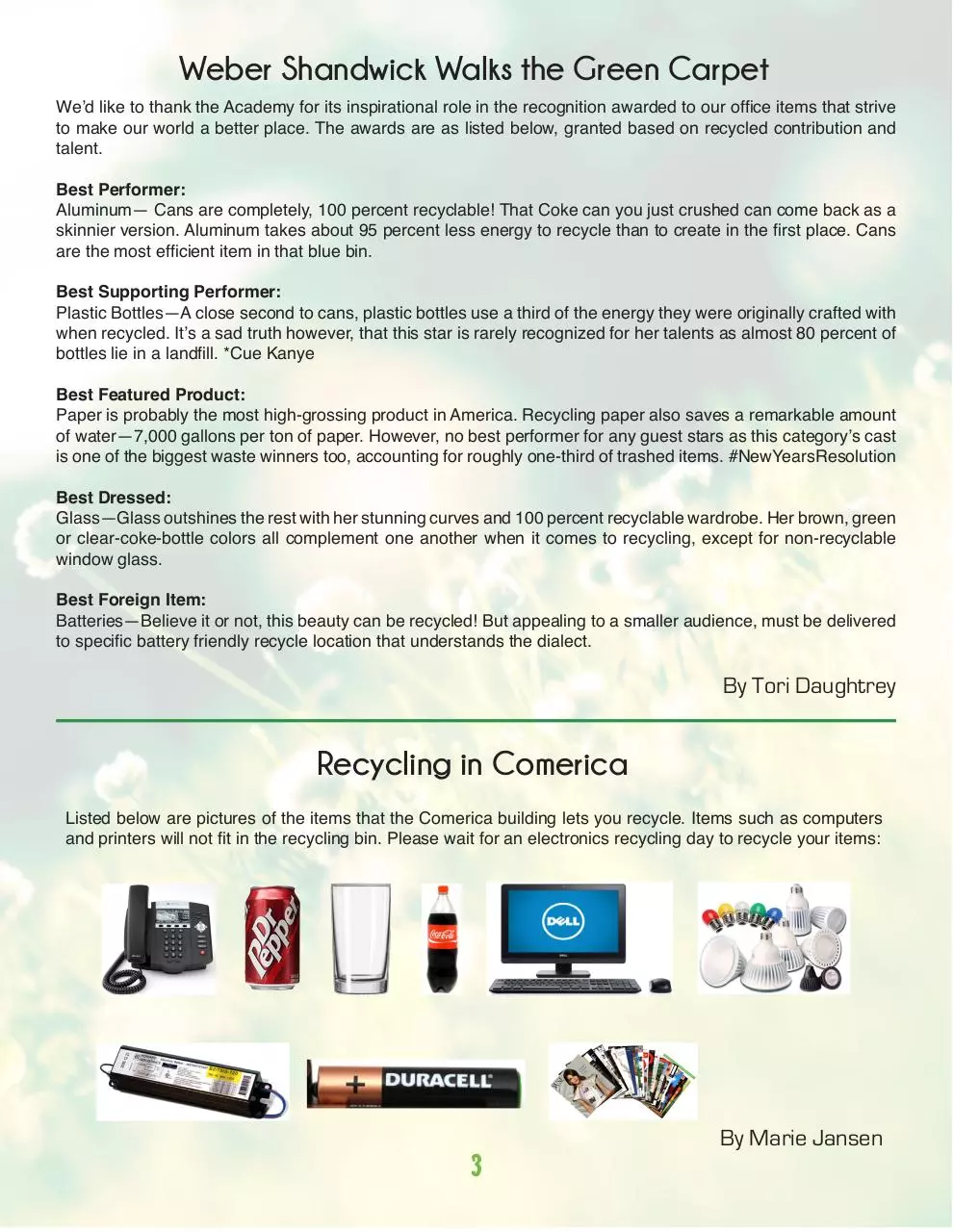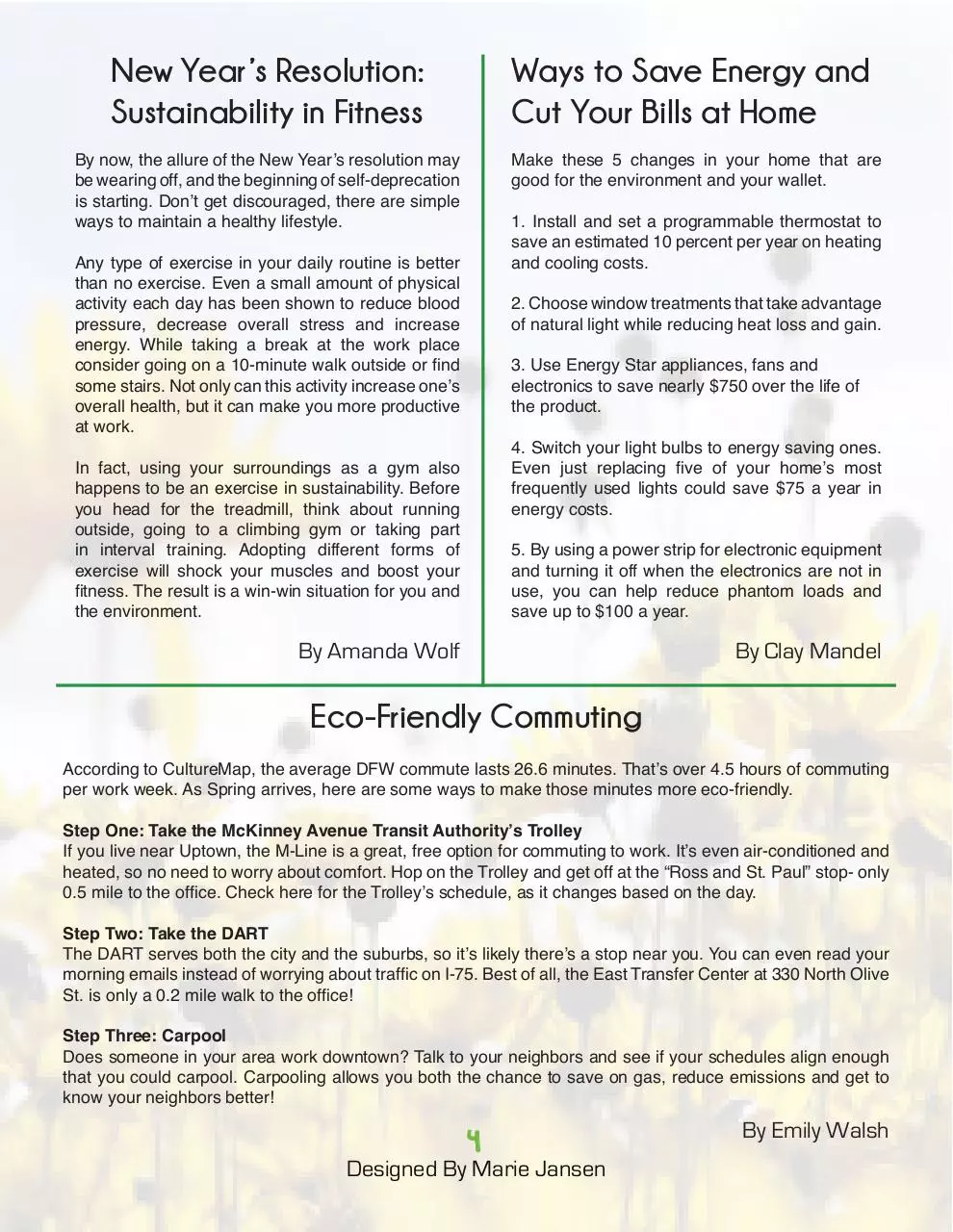WSSW ECOnewsletter PDF (PDF)
File information
This PDF 1.4 document has been generated by Adobe InDesign CC 2014 (Macintosh) / Adobe PDF Library 11.0, and has been sent on pdf-archive.com on 23/03/2015 at 22:07, from IP address 38.114.x.x.
The current document download page has been viewed 487 times.
File size: 865.41 KB (4 pages).
Privacy: public file




File preview
ECOnnection
MARCH 2015
1
Courtesy of WSSW
Spring 2015 Interns
Wonderful Uses for Lemon Peels
“Greenify” Your Garden
Instead of throwing your peels away, re-use them:
•
Gardening is the perfect spring
activity, so why not make your garden
“greener” this season?
Lemon all-purpose cleaner: Great for cutting grease and
disinfecting! Place lemon peels in any sized jar, pour
white vinegar over, cover and let sit for two weeks. Strain
the liquid and add water for a 50/50 ratio.
•
Deodorize the garbage disposal: Put a couple peels in
your disposal and flip the switch with the water running
to help give it a nice citrus scent.
•
Lemon Sugar Scrub: Mix ½ a cup of sugar with finely
chopped lemon peel and enough olive oil to make a
paste for a clean scented body exfoliant.
•
Clean stainless steel, chrome and copper: To remove
annoying residue, sprinkle sea salt on the metal and use
a lemon peel to scrub away any grime or stains. Rinse
and polish!
Start a compost pile – Composting
is collecting your old kitchen scraps,
which is then converted into nutrient
rich food for your soil. Fruit and
veggie scraps, egg shells, tea bags,
coffee grounds, nuts and shells, wood
shavings, leaves, etc. can all be used
to create compost. Try to keep a 50/50
ratio of green (vegetables, grass) to
brown (leaves, coffee grounds, nut
shells, etc.).
Pick your soil – Commercial potting
soils often contain chemicals. Ditch
the cheap soil and invest in organic.
Not only is it better for the earth, it’s
better for you especially if you grow
vegetables in your garden!
By Ava Batansky
10 Ways to Have an
Eco-Friendly Easter
Save water – Remember to water
your garden during the coolest part of
the day. Water has a better chance of
seeping in and being fully absorbed,
rather than evaporated. Using a rain
barrel to collect rainwater is another
great way to conserve.
1. Replace plastic eggs with real or wooden eggs
2. Buy eggs from a local farmer to support fair animal
treatment
3. Dye your eggs with natural or Earth Paint dyes
Use organic seeds – Much like
the soil, the seeds you use are very
important. In conventional seed
production, pesticides are applied at
much higher levels than allowed for
food crops. Organic seeds are better
suited for the local environment and
often produce better tasting fruits and
vegetables.
4. Buy a second-hand Easter basket or reuse your old one
5. Shred up a paper bag or old wrapping paper instead of
plastic grass
6. Buy fair trade chocolate to support workers’ rights
7. Fill baskets with plants, seed packets, or even small trees
that can be replanted in the garden rather than candy
10. Spend the day outdoors at a park, zoo, brunch, or picnic
Don’t use chemicals – Banish
chemical fertilizers and pesticides
from your garden.
Find natural
products to replace them, such as
vinegar solutions to battle weeds
(apply only to weeds, not plants).
Organic herbicides are also available
in stores.
By Sarah Rivers
By April Lesiuk
8. Save your egg shells for the compost
9. Make your celebration even more meaningful by giving
back to the community
2
Weber Shandwick Walks the Green Carpet
We’d like to thank the Academy for its inspirational role in the recognition awarded to our office items that strive
to make our world a better place. The awards are as listed below, granted based on recycled contribution and
talent.
Best Performer:
Aluminum— Cans are completely, 100 percent recyclable! That Coke can you just crushed can come back as a
skinnier version. Aluminum takes about 95 percent less energy to recycle than to create in the first place. Cans
are the most efficient item in that blue bin.
Best Supporting Performer:
Plastic Bottles—A close second to cans, plastic bottles use a third of the energy they were originally crafted with
when recycled. It’s a sad truth however, that this star is rarely recognized for her talents as almost 80 percent of
bottles lie in a landfill. *Cue Kanye
Best Featured Product:
Paper is probably the most high-grossing product in America. Recycling paper also saves a remarkable amount
of water—7,000 gallons per ton of paper. However, no best performer for any guest stars as this category’s cast
is one of the biggest waste winners too, accounting for roughly one-third of trashed items. #NewYearsResolution
Best Dressed:
Glass—Glass outshines the rest with her stunning curves and 100 percent recyclable wardrobe. Her brown, green
or clear-coke-bottle colors all complement one another when it comes to recycling, except for non-recyclable
window glass.
Best Foreign Item:
Batteries—Believe it or not, this beauty can be recycled! But appealing to a smaller audience, must be delivered
to specific battery friendly recycle location that understands the dialect.
By Tori Daughtrey
Recycling in Comerica
Listed below are pictures of the items that the Comerica building lets you recycle. Items such as computers
and printers will not fit in the recycling bin. Please wait for an electronics recycling day to recycle your items:
3
By Marie Jansen
New Year’s Resolution:
Sustainability in Fitness
Ways to Save Energy and
Cut Your Bills at Home
By now, the allure of the New Year’s resolution may
be wearing off, and the beginning of self-deprecation
is starting. Don’t get discouraged, there are simple
ways to maintain a healthy lifestyle.
Make these 5 changes in your home that are
good for the environment and your wallet.
1. Install and set a programmable thermostat to
save an estimated 10 percent per year on heating
and cooling costs.
Any type of exercise in your daily routine is better
than no exercise. Even a small amount of physical
activity each day has been shown to reduce blood
pressure, decrease overall stress and increase
energy. While taking a break at the work place
consider going on a 10-minute walk outside or find
some stairs. Not only can this activity increase one’s
overall health, but it can make you more productive
at work.
2. Choose window treatments that take advantage
of natural light while reducing heat loss and gain.
3. Use Energy Star appliances, fans and
electronics to save nearly $750 over the life of
the product.
4. Switch your light bulbs to energy saving ones.
Even just replacing five of your home’s most
frequently used lights could save $75 a year in
energy costs.
In fact, using your surroundings as a gym also
happens to be an exercise in sustainability. Before
you head for the treadmill, think about running
outside, going to a climbing gym or taking part
in interval training. Adopting different forms of
exercise will shock your muscles and boost your
fitness. The result is a win-win situation for you and
the environment.
5. By using a power strip for electronic equipment
and turning it off when the electronics are not in
use, you can help reduce phantom loads and
save up to $100 a year.
By Amanda Wolf
By Clay Mandel
Eco-Friendly Commuting
According to CultureMap, the average DFW commute lasts 26.6 minutes. That’s over 4.5 hours of commuting
per work week. As Spring arrives, here are some ways to make those minutes more eco-friendly.
Step One: Take the McKinney Avenue Transit Authority’s Trolley
If you live near Uptown, the M-Line is a great, free option for commuting to work. It’s even air-conditioned and
heated, so no need to worry about comfort. Hop on the Trolley and get off at the “Ross and St. Paul” stop- only
0.5 mile to the office. Check here for the Trolley’s schedule, as it changes based on the day.
Step Two: Take the DART
The DART serves both the city and the suburbs, so it’s likely there’s a stop near you. You can even read your
morning emails instead of worrying about traffic on I-75. Best of all, the East Transfer Center at 330 North Olive
St. is only a 0.2 mile walk to the office!
Step Three: Carpool
Does someone in your area work downtown? Talk to your neighbors and see if your schedules align enough
that you could carpool. Carpooling allows you both the chance to save on gas, reduce emissions and get to
know your neighbors better!
4
Designed By Marie Jansen
By Emily Walsh
Download WSSW ECOnewsletter PDF
WSSW ECOnewsletter PDF.pdf (PDF, 865.41 KB)
Download PDF
Share this file on social networks
Link to this page
Permanent link
Use the permanent link to the download page to share your document on Facebook, Twitter, LinkedIn, or directly with a contact by e-Mail, Messenger, Whatsapp, Line..
Short link
Use the short link to share your document on Twitter or by text message (SMS)
HTML Code
Copy the following HTML code to share your document on a Website or Blog
QR Code to this page

This file has been shared publicly by a user of PDF Archive.
Document ID: 0000216830.